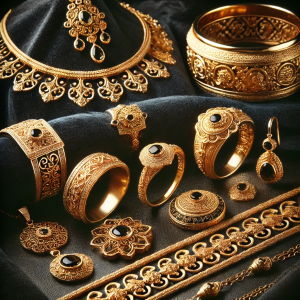 Gold: The Eternal Symbol of Wealth and Beauty
Gold: The Eternal Symbol of Wealth and Beauty
For centuries, gold has captivated civilizations with its luminous allure and its enduring value. Revered not only for its beauty but also for its practicality, gold holds a unique place in the fabric of human history. From the earliest days of ancient empires to the modern financial markets, this precious metal has been sought after, admired, and revered. But what is it about gold that elevates it above other materials, ensuring its status as a symbol of power, wealth, and timeless beauty?
A Glimmer Through History
The story of gold begins long before the first human empires were founded. Gold’s natural beauty, combined with its rarity, made it one of the earliest materials coveted by humans. Archaeological findings reveal that as early as 4,600 BC, ancient societies in Europe and Mesopotamia used gold to craft jewellery and religious artifacts. The Egyptians, with their obsession for the eternal, adorned their temples and tombs with this shining metal, believing it to be the flesh of the gods. Pharaohs were laid to rest in gold-encrusted sarcophagi, a testament to the material’s association with divine and royal power.
Beyond Egypt, the story of gold weaves through the Roman Empire, where it became a cornerstone of the economy, to the Incan civilization, which called it “the sweat of the sun.” Its cultural resonance is not confined to one region or one era. Gold has been, and continues to be, a universal emblem of wealth and status.
Properties Beyond the Aesthetic
 Gold’s allure is not purely visual. Its physical properties have contributed significantly to its value. The metal is chemically inert, meaning it does not tarnish or corrode over time, maintaining its shine and form across millennia. This characteristic has solidified its reputation as a material of permanence, ideal for crafting objects meant to last—whether in fine jewellery or in coins that passed through generations.
Gold’s allure is not purely visual. Its physical properties have contributed significantly to its value. The metal is chemically inert, meaning it does not tarnish or corrode over time, maintaining its shine and form across millennia. This characteristic has solidified its reputation as a material of permanence, ideal for crafting objects meant to last—whether in fine jewellery or in coins that passed through generations.
Moreover, gold is highly malleable and ductile. Just one gram of gold can be stretched into a thread more than two kilometers long, allowing artisans to create intricate designs with extraordinary precision. This softness also allows for gold to be alloyed with other metals, which enhances its durability and expands its aesthetic palette, resulting in an array of colors, from white and rose to the classic yellow.
Gold in Economics: The Standard of Wealth
The role of gold in economic history is profound. For much of human history, gold was the backbone of global finance. Its rarity and the difficulty of extraction made it a reliable store of value, leading to its use as currency. From the ancient Lydians, who minted the first gold coins, to the adoption of the Gold Standard in the 19th century, this metal shaped economies. Under the Gold Standard, a country’s currency was directly linked to a specified amount of gold, ensuring stability and trust in the monetary system.
Though the Gold Standard was abandoned in the 20th century, gold continues to serve as a safe haven for investors, particularly in times of economic uncertainty. When currencies fluctuate and markets destabilize, gold retains its appeal as a tangible, immutable asset, providing a sense of security in a volatile world.
Gold as a Cultural and Artistic Icon
Gold’s allure has transcended the realm of economics, embedding itself in art, religion, and culture. Its warm glow and scarcity made it the ideal medium for religious artifacts, from the gilded domes of Byzantine churches to the intricate details of Hindu temple idols. In art, gold leaf has been used for centuries to give paintings and sculptures an ethereal quality, reflecting divine light and imbuing the work with a sense of holiness.
One of the most iconic uses of gold in art comes from Gustav Klimt, whose famous “Golden Phase” introduced gold leaf into his paintings, resulting in works that shimmer with life and opulence. Gold’s malleability allowed for intricate details, adding a richness to his portraits and landscapes that few other materials could match.
Gold Today: Innovation Meets Tradition
While gold’s role as a monetary standard may have evolved, its significance remains undiminished. Today, gold continues to be a preferred material in high-end jewellery, with iconic pieces from luxury brands symbolizing not only wealth but also craftsmanship. Its resistance to tarnishing ensures that such pieces, often passed down through generations, retain their value and beauty.
In the modern age, gold is also used in advanced technologies, from aerospace to electronics, because of its excellent conductivity and resistance to corrosion. Whether in the circuitry of your smartphone or the visor of an astronaut’s helmet, gold plays a critical role in shaping the future.
The Eternal Metal
 Gold’s mystique endures, intertwined with our history, culture, and innovation. From the treasures of ancient tombs to the cutting-edge technologies of today, gold remains a symbol of the eternal—a material that has, and will continue to, transcend time. Its value, both tangible and intangible, is unparalleled, making it not just a precious metal but a priceless part of human heritage.
Gold’s mystique endures, intertwined with our history, culture, and innovation. From the treasures of ancient tombs to the cutting-edge technologies of today, gold remains a symbol of the eternal—a material that has, and will continue to, transcend time. Its value, both tangible and intangible, is unparalleled, making it not just a precious metal but a priceless part of human heritage.
In a world that constantly changes, gold’s gleaming presence reminds us of the enduring nature of beauty, wealth, and the human desire for something everlasting. It is, and always will be, the metal of kings, artists, and dreamers alike.
